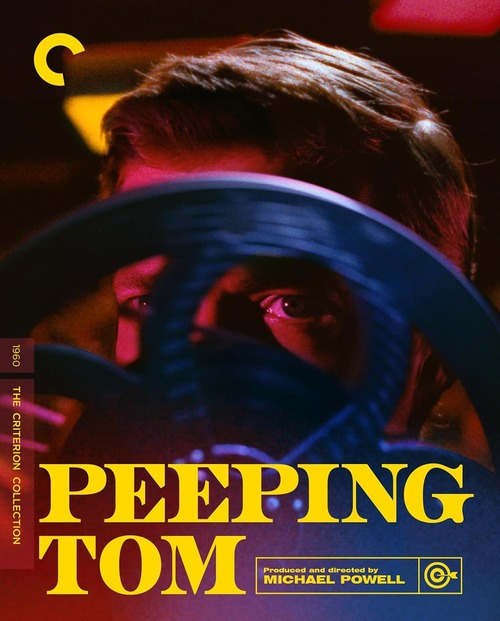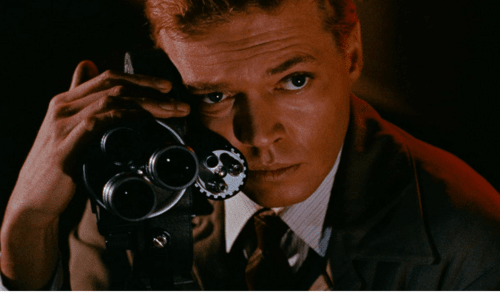
“THE
BRITISH PSYCHO”
By
Raymond Benson
The
acclaimed filmmaker Michael Powell, who had enjoyed a magnificent ten-year
collaboration with producer/writer Emeric Pressburger between 1941-1951 (they
were known as “The Archers), set off on his own in the remainder of the 50s.
His career was unfairly and abruptly cut short, in Britain at least, with the
release of Powell’s 1960 feature, Peeping Tom.
The
UK premiere of Peeping Tom occurred just three months before the US
premiere of Alfred Hitchcock’s Psycho, and in many ways Powell’s movie was
a preview of what was to come from “The Master of Suspense”. Many film
historians have called Peeping Tom the “British Psycho” because
the picture deals with a serial killer, it contains shocking sequences, and
there are themes of psychoanalysis and kinky sexual obsessions in the movie’s
DNA, just like its American counterpart.
But
the two films cannot be more different.
For
one thing, Peeping Tom lacks the dark humor that Hitchcock laced
throughout Psycho. Hitchcock himself had referred to his movie as a
“comedy,” even though it’s now considered one of the greatest horror films ever
made. Secondly, Psycho is immensely suspenseful, edge-of-the-seat stuff,
and it’s a wild ride at the cinema. It was one heck of an entertaining piece of
celluloid, and it still is. Peeping Tom, on the other hand, takes itself
very seriously, is more of a slow burn, and concentrates more on the killer in
terms of human flaws. Whereas Anthony Perkins’ Norman Bates at first seems to
be a nervous, introverted mama’s boy who deserves our empathy—until he doesn’t!—Carl
Boehm’s Mark Lewis (“Carl Boehm” was the screen name at the time for
German/Austrian actor Karlheinz Böhm) is a character
who wants the audience’s sympathy from the get-go and all the way through to
the character’s tragic ending.
Mark
Lewis was raised by a sadistic psychoanalyst father (who is portrayed
uncredited by director Michael Powell himself, and young Mark is played by
Powell’s son, Columba Powell, also uncredited). Dr. Lewis was fascinated by the
emotion fear. He performed years of “experiments” on his son to test the boy’s
own fear, often filming the results for posterity. Mark grew up psychologically
scarred, but he also became a talented and prolific cameraman. His day job is
that of a focus-puller for a British film studio, but by night he indulges in
his own personal filmmaking—that of making “snuff” films of women he first
frightens in order to film their reactions, and then murders while the camera’s
still rolling. He then spends hours in his makeshift dark room and home cinema
running the films for his private pleasure. Some of these women include
actress/dancer Vivian (Moira Shearer) and model Milly (Pamela Green). When Mark
is befriended by his downstairs neighbor, Helen (Anna Massey), he desires to
open up to her about his particular perversion. To reveal more would spoil the
fun, such as it is.
Okay,
one can possibly understand how the very conservative (at the time) British
public and critics might have viewed this in-your-face and very adult motion
picture in early 1960, which frankly was still the 1950s in sensibilities. Peeping
Tom was savaged by the press. The picture played only a week or two before
the studio pulled it from cinemas. It didn’t open in the US until 1962, and
there it was marketed as an exploitation horror film in only a few theaters in
the country. Peeping Tom subsequently disappeared for years, becoming a
cult title which few people had actually seen.

Martin
Scorsese, as a film student at NYU and burgeoning director in the 1960s, had
heard of the movie and was just beginning to discover the works of Powell and
Pressburger, but seeing Peeping Tom eluded him until 1970. From then on,
Scorsese championed the picture and put forth funds to help get the title
re-released. His longtime editor, Thelma Schoonmaker, who eventually married
Powell, also joined in with the reappraisals of the movie both in the US and,
finally, in the UK. Today, Peeping Tom is considered a masterpiece of
psychological horror, one that can favorably be compared to Psycho,
if such a comparison must be made.
For
this reviewer, Psycho will always be the superior film, but Peeping
Tom is a worthwhile cinematic excursion into madness and murder. It is, though,
as noted, certainly a different kind of experience.
The
Criterion Collection released Peeping Tom on DVD way back in the late
1990s, but the company has now issued the film again in a brand new 4K digital
restoration with an uncompressed monaural soundtrack. The 2-disk package
contains the movie as a 4K UHD disc presented in Dolby Vision HDR, and as a Blu-ray
with special features on a second disc. The images look spectacularly crisp and
clean, accenting the dark but vibrant coloring of the photography by Otto
Heller.
Two
audio commentaries can be selected. One features film historian Ian Christie
and the other features film scholar Laura Mulvey. Supplements include an
introduction by Martin Scorsese; an interview with Thelma Schoonmaker; a
documentary about the film’s history featuring Schoonmaker, Scorsese, and actor
Böhm; and a documentary about the screenwriter,
Leo Marks, who coincidentally was the owner of the London bookstore that was
the inspiration for the fictional 84 Charing Cross Road shop; a piece on
the film’s restoration; and the theatrical trailer. There are English subtitles
for the hearing impaired. An essay by author Megan Abbott adorns the booklet.
Peeping
Tom is
a slice of British filmmaking that has luckily found its proper place in the
legacy of one of that country’s greatest directors. For fans of Michael Powell,
horror films, slasher pictures, and British cinema.
Click here to order from Amazon